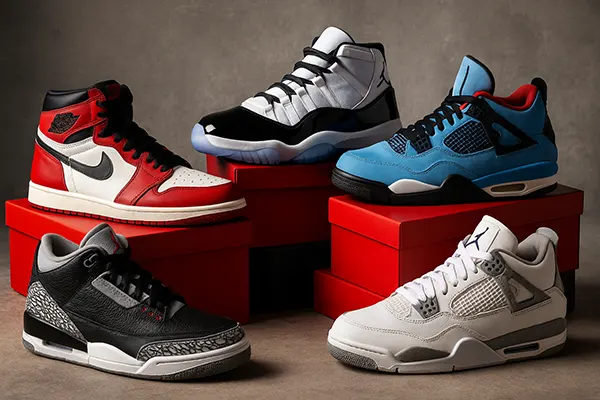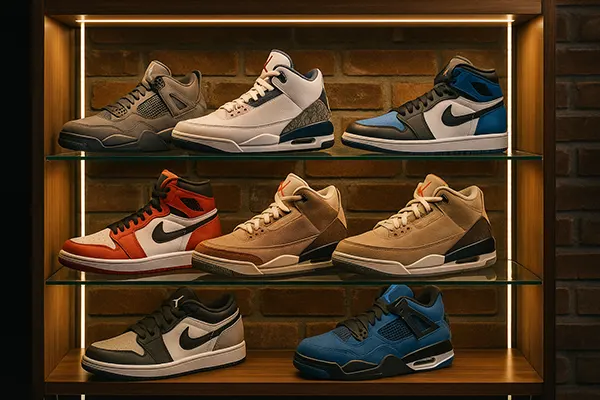
Archive: Rare Jordan Sneakers That Became Iconic — History, Price, and Authenticity Tips
Since their debut in 1985, Air Jordan sneakers have evolved from basketball gear into global cultural icons. Some rare models have reached legendary status, commanding extraordinary prices and inspiring a devoted community of collectors. In this guide, we explore the history behind the most sought-after Jordans, their current market value in 2025, and how to distinguish genuine pairs from counterfeits.
The Most Coveted Air Jordan Models
Among hundreds of releases, a handful of Air Jordans stand out as collector’s dreams. The Air Jordan 1 “Chicago” (1985) remains the holy grail — originally retailing for under $70, it now fetches over £20,000 in mint condition. Its historical significance lies in defining sneaker culture and the NBA’s “banned shoe” narrative, which elevated it to cult status.
Another rare masterpiece is the Air Jordan 11 “Concord” (1995), worn by Michael Jordan during his triumphant return to basketball. The patent leather silhouette revolutionised design aesthetics, and pristine deadstock pairs can reach £8,000 or more at auctions. Its mix of elegance and sport performance solidified Jordan Brand’s dominance.
Collectors also chase the Air Jordan 4 “Eminem Encore” (2005), limited to just 50 pairs. Produced for Eminem’s album release, it represents the fusion of music and sneaker culture. Today, authentic pairs are valued around £40,000–£60,000 depending on condition and provenance.
Special Editions and Collaborations
Collaborations have propelled Air Jordans into fashion and art. The Air Jordan 1 x Off-White (2017) by Virgil Abloh reimagined the silhouette through deconstruction and industrial typography. With fewer than 10,000 pairs released, resale prices in 2025 hover near £6,000. This model set a new benchmark for designer–sneaker partnerships.
Another exclusive is the Air Jordan 4 x Travis Scott “Friends and Family” edition (2018). Only a few dozen pairs were distributed privately, pushing their value beyond £25,000. Its unique blue suede and reversed Swoosh distinguish it from the public release.
The Air Jordan 3 “DJ Khaled We The Best” (2022) achieved cultural relevance by combining nostalgia with modern luxury. While general pairs retail affordably, the limited “Purple Velvet” editions exceed £5,000 in collector markets today.
Market Trends and Investment Value in 2025
By 2025, the resale sneaker economy is projected to surpass £10 billion globally, with Air Jordans leading the charge. Rare releases from the 1980s and 1990s remain stable investments, showing consistent annual appreciation between 10% and 25%, depending on condition and authenticity verification.
Newer collaborations, particularly those tied to artists and designers, also hold value, but experts caution that oversaturation could affect returns. Nonetheless, models like the Air Jordan 1 “Lost & Found” (2022) maintain strong demand due to their link to original colourways and accessible price range around £400–£600.
Collectors increasingly rely on third-party authentication platforms such as StockX, GOAT, and eBay Authenticity Guarantee. Transparent pricing data and blockchain-based verification systems have enhanced market reliability and reduced counterfeit risks.
Where and How to Buy Authentic Jordans
Authentic Jordans can be purchased from authorised retailers like Nike SNKRS, END Clothing, and Flight Club. For vintage pairs, auction houses such as Sotheby’s or Goldin Auctions specialise in certified collections. Always verify provenance and request condition reports before investing.
Digital resale platforms now include authenticity guarantees with physical inspections, RFID tags, and tamper-proof packaging. This ensures that each pair is verified by trained specialists using UV scans and stitching analysis.
Buyers should prioritise transparency and avoid suspiciously low offers, particularly on social media or unverified resellers. Consistency in packaging, receipts, and serial numbers is essential when purchasing collectible Jordans.

How to Identify Fake Jordans
Counterfeit Jordans have become increasingly sophisticated, making knowledge crucial for buyers. Begin by examining the shoe box: authentic Jordans feature high-quality print, accurate labelling, and consistent barcodes matching online product IDs. Poor ink quality or colour discrepancies are early warning signs.
Inspect stitching and materials carefully. Genuine Jordans use premium leather, suede, and textiles, while fakes often have uneven seams, glue stains, and incorrect textures. Authentic pairs exhibit symmetry and flawless craftsmanship — particularly around the heel tab and Jumpman logo.
Inside the shoe, check the tag details and insole. Authentic labels display the correct font, spacing, and production date range consistent with release records. QR codes can be scanned directly to Nike’s database to confirm legitimacy.
Expert Advice for Collectors
Collectors recommend documenting every purchase, including photos of the box, receipt, and authentication certificate. This not only confirms legitimacy but also increases resale value over time. Proper storage — away from sunlight and humidity — prevents yellowing and material degradation.
Consider investing in protective display cases with UV-resistant glass. These help preserve the sneakers’ condition and serve as stylish showcases for collectors. Regular cleaning with non-acidic wipes maintains appearance without damaging the material.
Ultimately, the value of rare Jordans extends beyond money — they symbolise sports history, creativity, and identity. Understanding their legacy and authenticity ensures collectors keep the true spirit of Michael Jordan alive through every pair.
